Related Research Articles
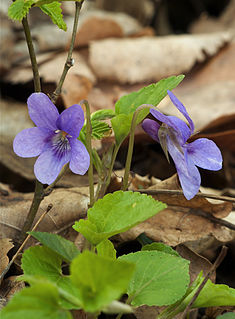
Viola is a genus of flowering plants in the violet family Violaceae. It is the largest genus in the family, containing between 525 and 600 species. Most species are found in the temperate Northern Hemisphere; however, some are also found in widely divergent areas such as Hawaii, Australasia, and the Andes.

Gesneriaceae, the gesneriad family, is a family of flowering plants consisting of about 152 genera and ca. 3,540 species in the tropics and subtropics of the Old World and the New World, with a very small number extending to temperate areas. Many species have colorful and showy flowers and are cultivated as ornamental plants.
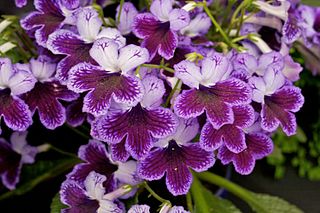
A popular house plant, Streptocarpus, is an Afrotropical genus of flowering plants in the family Gesneriaceae. The genus is native to Afromontane biotopes from central, eastern and southern Africa, including Madagascar and the Comoro Islands. The flowers are five-petalled, salverform tubes, almost orchid-like in appearance, and hover or arch over the plant, while the pointed, elongate fruit is of a helical form similar to that of the "tusk" of a narwhal. In the wild, species can be found growing on shaded rocky hillsides or cliffs, on the ground, in rock crevices, and almost anywhere the seed can germinate and grow. For the home, there are now many hybrids of various colours and forms available.

Streptocarpus sect. Saintpaulia is a section within Streptocarpus subgenus Streptocarpella consisting of about ten species of herbaceous perennial flowering plants in the family Gesneriaceae, native to Tanzania and adjacent southeastern Kenya in eastern tropical Africa. The section was previously treated as a separate genus, Saintpaulia, but molecular phylogenetic studies showed that it was nested within the genus Streptocarpus.

The American Rose Center is a rose garden in Shreveport, Louisiana owned and operated by The American Rose Society. There are over 20,000 rose bushes of 100 varieties in 65 separate rose gardens on 118 acres of pine forests and woodlands.
Streptocarpus inconspicuus, synonym Saintpaulia inconspicua, is a species of Streptocarpus in the section Saintpaulia. It is a rare African violet, found in the Uluguru Mountains in Tanzania, East Africa. It was first formally described in 1958. It is classed as an endangered species by the IUCN Red List.

Brian Laurence "Bill" Burtt FRSE FLS, was an English botanist and taxonomist who is noted for his contributions to the family Gesneriaceae. In a career that spanned 74 years, he worked first at the Royal Botanic Gardens, Kew, and then at the Royal Botanic Garden Edinburgh (RBGE). He made numerous field trips to South Africa and Sarawak and described a total of 637 new plant species. Burtt is denoted by the author abbreviation B.L.Burtt when citing a botanical name.
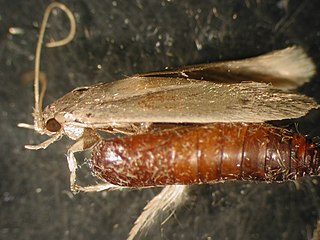
Opogona sacchari, the banana moth, is a moth of the family Tineidae. The species was first described by Wenceslas Bojer in 1856. It is native to the humid tropical and subtropical regions of sub-Saharan Africa, where it is also found in Madagascar, Mauritius, Réunion, Rodrigues Island, the Seychelles and St. Helena. It was first reported from the Canary Islands in the 1920s. In the 1970s, it was introduced into Brazil and Central America, and also appeared in Europe. It has been reported from Florida since 1986.

A rose show is a horticultural exhibition focusing exclusively on roses.
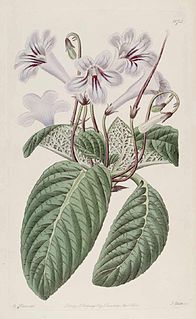
Streptocarpus rexii is a South African plant in the family Gesneriaceae, occurring widely from the southern Cape along the coastal hills, mountains, wooded ravines and valleys, and moist forests of the east coast, through Natal as far north as the Eastern Transvaal, up to an altitude of about 900 m. This genus of epiphytes and lithophytes, of about 130 species, is mainly African and Mascarene, with four vagrant species in Asia. Streptocarpus, as do other Old World Gesneriaceae, is unusual in that it displays anisocotylous or unequal growth, i.e. one cotyledon continues to grow after germination.

Streptocarpus goetzeanus, synonym Saintpaulia goetzeana, is a species of Streptocarpus in the section Saintpaulia, commonly known as an African violet. It is a small, flowering plant that is used widely in home horticulture. S. goetzeana was first collected in 1898 by W. Goetze, and it was later described as a species by Engler in 1900.

The Didymocarpoideae are a subfamily of plants in the family Gesneriaceae. It was formerly the subfamily Cyrtandroideae. This subfamily consists mostly of tropical and subtropical Old World genera, found in Africa, Asia and the Pacific. One species is native to Central and South America.

Streptocarpus ionanthus is a species of Streptocarpus in the section Saintpaulia, commonly known as an African violet. It is native to eastern and southwestern Tanzania.
Streptocarpus albus is a species of flowering plant in the family Gesneriaceae, native to Tanzania. It was first described in 1933 as Saintpaulia alba. It is found in the Uluguru and Nguru mountains of Tanzania.
Streptocarpus brevipilosus is a species of flowering plant in the family Gesneriaceae, native to Tanzania. It was first described in 1964 as Saintpaulia brevipilosa. The former genus Saintpaulia was reduced to Streptocarpus sect. Saintpaulia in 2015, and the species moved to Streptocarpus. It is found in the Nguru Mountains of Tanzania.
Streptocarpus nitidus is a species of flowering plant in the family Gesneriaceae, native to Tanzania. It was first described in 1958 as Saintpaulia nitida. The former genus Saintpaulia was reduced to Streptocarpus sect. Saintpaulia in 2015, and the species moved to Streptocarpus. Streptocarpus nitidus has also been treated as a subspecies of Streptocarpus ionanthus.
Streptocarpus ulugurensis is a species of flowering plant in the family Gesneriaceae, native to Tanzania. It was first described in 2009 as Saintpaulia ulugurensis. The former genus Saintpaulia was reduced to Streptocarpus sect. Saintpaulia in 2015, and the species moved to Streptocarpus.
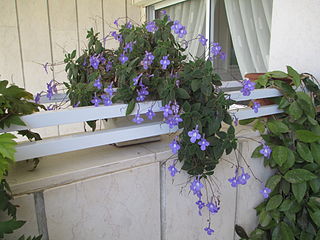
Streptocarpus saxorum, called the false African violet, is a species of flowering plant in the genus Streptocarpus, subgenus Streptocarpella, native to Kenya and Tanzania. It is an evergreen perennial that often bears flowers nearly year-round. Its "compact" variety has gained the Royal Horticultural Society's Award of Garden Merit as a houseplant.

Walter von Saint Paul-Illaire or Adalbert Emil Walter Le Tanneux von Saint Paul-Illaire was a German colonial official in East Africa. He hailed from the noble family of Le Tanneux von Saint Paul, which had moved to Prussia in the 17th century. The genus Saintpaulia of the African violet was named in his honour after he discovered it in the Usambara Mountains and had sent its seeds in 1893 to Hermann Wendland, the German botanist and Chief Royal gardener at the Herrenhausen Gardens in Hanover, who gave the plant its first description, calling it the Usambara veilchen